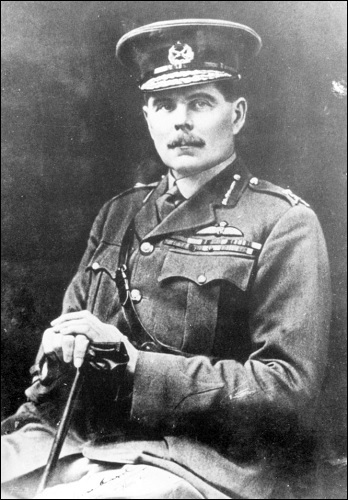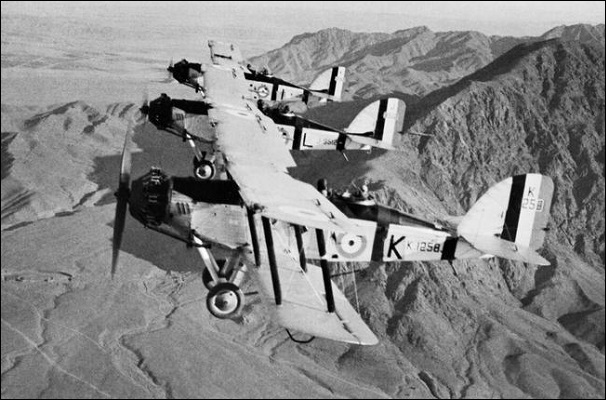● ● ●
At the beginning of the First World
War the airplane was viewed with skepticism by senior
military commanders—who thought that at most, it might be a
useful supplement to cavalry in the reconnaissance role.
But by Armistice Day 1918 the airplane had matured into a
formidable weapon of war. It first proved itself as an
instrument of tactical reconnaissance, a mission it carried
out far more
effectively than the cavalry. Each side therefore sought to
counter the other’s aerial reconnaissance activities by
developing armed pursuit aircraft, and soon these were engaging one another in air-to-air combat. Meanwhile the
larger two-seat reconnaissance and observation aircraft
acquired armament and assumed an active combat role, bombing
and strafing enemy ground targets. And if the enemy’s forces
in the field could be bombed, why not his rear
communications, war industries, railroads—even his cities?
This idea of using airplanes to
attack the enemy’s homeland was not a new one. It was a
staple of prewar fantastic fiction, for example in H.G.
Wells’ 1914 novel The World Set Free (which also
contained a prediction of atomic weapons). During the Great
War the first such air attack occurred on the night of 24–25
August 1914, when a German Zeppelin (airship) dropped bombs
on the Belgian city of Antwerp. The first sustained
strategic air offensive was conducted by Germany against
Britain between 1915 and 1918. These attacks were carried
out initially by Zeppelins, later supplemented by the twin-engine Gotha bomber,
which hand been specifically developed for the purpose. Though
it
caused comparatively little damage, German bombing
both outraged and alarmed the British government and public, and
caused significant resources to be diverted from the
fighting fronts to home defense.
The Allies in turn carried out sporadic
air attacks on cities in western Germany between 1915 and 1917,
and the idea of strategic bombing began gradually to gain
supporters. By 1918 Britain’s Royal Air Force (established
on 1 April of that year by amalgamating the Army’s Royal
Flying Corps with the Royal Naval Air Service) possessed a
strategic air arm in the form of the Independent Bombing
Force (IBF). Beginning in June of that year the IBF
conducted a strategic bombing offensive by day and night
against transportation and industrial targets in western
Germany. But these attacks coincided with the German Army’s
great final offensive on the Western Front, and the IBF was
frequently diverted from its strategic mission to provide
air support for the Allied armies.

The Father of the RAF: Major-General Sir Hugh Trenchard,
Commander of the Royal Flying Corps 1915-17. He
became the first Chief of the Air Staff when the
RAF was established on 1 April
1918, then commanded the Independent Bomber Force, and
finally resumed the position of Chief of the Air Staff,
serving from 1919 to 1930. (Imperial War Museum)
As with the German raids on Britain
the RAF’s strategic bombing of Germany in 1918 caused no
very serious damage to German industries or cities, and many
aircraft were lost. But they were thought to have shown
promise and plans were drawn up for a much more powerful
effort in 1919—short-circuited by the collapse of German
resistance in the autumn of 1918.
The end of the war brought problems
for the RAF, its continued existence becoming a subject for
acrimonious debate. The Army and the Royal Navy had been
less than pleased to give up their air arms to the new
service and in the first years of peace there were repeated
calls, particularly from the Navy, for the abolition of the
RAF—supposedly as a cost-saving measure. Necessity is the
mother of invention, and to some extent sheer
self-preservation motivated the postwar RAF’s fervent embrace of the
doctrine of strategic bombing. In response to Army and Navy
arguments against the continued existence of their service,
the RAF’s leaders with the Chief of the Air Staff, Air
Chief Marshal Sir Hugh Trenchard, at their head, argued that
the future of war belonged to the air. The RAF, they
claimed, would take the fight directly to the enemy’s
heartland, destroying his war-making capacity and national
morale by bombing. Airpower would relegate the other armed
services to secondary roles.
But during the 1920s, parsimonious
defense budgets frustrated hopes for the creation of a strategic air
force. The requisite aircraft and infrastructure did not
exist and the British government, anxious to reduce defense
spending to an absolute minimum, would not give the
necessary money to develop them. Trenchard only kept the RAF
going by showing that air power could be a cost-effective
instrument for policing the empire. In Iraq and on India’s
Northwest Frontier, a few bombs usually sufficed to call
rebellious tribes to order, and most of the aircraft
procured for the RAF in the postwar decade were designed for
that mission.

Westland Wapiti light bombers
of the RAF over India's
Northwest Frontier Province, circa 1930 (Imperial War
Museum)
Even so, the concept of
strategic bombing, fostered by prophets of airpower like Trenchard, Billy Mitchell in the United States and Giulio
Douhet in Italy, captured the popular imagination. Arguing
that the airplane was destined to become the “winning
weapon,” they envisioned a massive aerial knockout blow that
would shatter the enemy’s war-making capacity and his will to
resist within days or even hours of a declaration of war.
This was an idea that came to be widely accepted. Science
fiction novels like Wells’ The Shape of Things to Come
and Olaf Stapledon’s
Last and First Men
presented just such alarming depictions of future wars—which
were all too credulously accepted.
More prosaically, debate in
military circles revolved around the validity of the airpower prophets’ vision. In Britain, for instance, there were
sharp disagreements over the likely effectiveness of air defenses:
fighter planes and antiaircraft guns.
Most RAF leaders argued that attack was the best defense and
that money would best be spent on
the strategic air arm. Others were not so sure, though Prime
Minister Stanley Baldwin, echoing Douhet, opined that “the
bomber will always get through.”
By
the mid-1930s, with Hitler in power, German rearmament
underway and the threat of a new European war looming larger
by the year, the debate over strategic bombing sharpened. The Nazi propaganda machine’s extravagant
claims regarding the newly established German air arm, the Luftwaffe,
tended to be uncritically accepted in other countries. The
frightful prospect of London and Paris laid in ruins by
bombs, their populations slaughtered in droves, was very
serviceable both to German diplomacy and to the French and
British antiwar movements. Yet frightening as they were,
such predictions of disaster failed to prevent the outbreak
of war on 1 September 1939. And as the sirens wailed in
London on the day that Britain declared war on Germany, it
remained to be seen how accurate they would prove to be,
when put to the test.
● ● ●